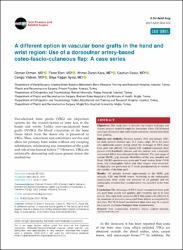A different option in vascular bone grafts in the hand and wrist region: Use of a dorsoulnar artery-based osteo-fascio-cutaneous flap: A case series

View/
Date
2021Author
Orman, OsmanEren, Fikret
Kara, Ahmet Duran
Cesur, Ceyhun
Yıldırım, Cengiz
Aysal, Bilge Kağan
Metadata
Show full item recordCitation
Orman O, Eren F, Kara AD, Cesur C, Yıldırım C, Aysal BK. A different option in vascular bone grafts in the hand and wrist region: Use of a dorsoulnar artery-based osteo-fascio-cutaneous flap: A case series. Jt Dis Relat Surg 2021;32(2):504-513.Abstract
Objectives: This study aims to describe our surgery technique and discuss patients treated through the dorsoulnar artery (DUA)-based technique of osseous and osteo-fascio-cutaneous vascularized ulnar bone grafting.
Patients and methods: Between January 2011 and January 2015, six male patients (median age: 22.5 years; range, 20 to 24 years) who underwent surgery during which the technique of DUA ulnar bone graft was utilized. One patient with scaphoid nonunion, three patients with Kienbock's disease, and two patients with a traumatic metacarpal defect were retrospectively evaluated. The joint range of motion (ROM), grip strength, Disabilities of the arm, shoulder and Hand (DASH) questionnaire score and Visual Analog Scale (VAS) score, and radiographies before and after surgery were examined. Scintigraphy was performed at 12 weeks postoperatively to monitor the viability of the bone graft.
Results: All patients showed improvements in the ROM, grip strength, VAS, and DASH scores. According to the radiographic examination, bone union was achieved in all patients and the scintigraphy revealed that vascularization was detected in the bone tissue.
Conclusion: The advantages of DUA-based vascularized bone graft are good bone quality and quantity and versatility due to its long pedicle. The osteo-fasio-cutaneous DUA flap seems to be effective in the treatment of traumatic metacarpal bone defects accompanied by skin loss. The DUA-based vascularized ulnar bone may be a source for scaphoid and lunate biological bone reconstruction.

















